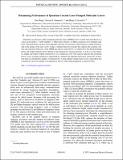Maximizing Performance of Quantum Cascade Laser-Pumped Molecular Lasers
Author(s)
Wang, Fan; Johnson, Steven G; Everitt, Henry O.
DownloadPhysRevApplied.16.024010.pdf (1.581Mb)
Publisher Policy
Publisher Policy
Article is made available in accordance with the publisher's policy and may be subject to US copyright law. Please refer to the publisher's site for terms of use.
Terms of use
Metadata
Show full item recordAbstract
Quantum-cascade-laser- (QCL) pumped molecular lasers (QPMLs) have recently been introduced as a source of powerful (>1 mW) tunable (>1 THz) narrow-band (<10 kHz) continuous-wave terahertz radiation. The performance of these lasers depends critically on molecular collision physics, pump saturation, and on the design of the laser cavity. Using a validated three-level model that captures the essential collision and saturation behaviors of the QPML gas nitrous oxide (N₂O), we explore how the threshold pump power and output terahertz power depend on the pump power and gas pressure, as well as on the diameter, length, and output-coupler transmissivity of a cylindrical cavity. The analysis indicates that maximum power occurs as pump saturation is minimized in a manner that depends much more sensitively on pressure than on cell diameter, length, or transmissivity. A near-optimal compact laser cavity can produce tens of milliwatts of power tunable over frequencies above 1 THz when pumped by a multiwatt QCL.
Date issued
2021-08Department
Massachusetts Institute of Technology. Department of Mathematics; Massachusetts Institute of Technology. Department of PhysicsJournal
Physics Review Applied
Publisher
American Physical Society (APS)
Citation
Wang, Fan et al. "Maximizing Performance of Quantum Cascade Laser-Pumped Molecular Lasers." Physics Review Applied 16, 2 (August 2021): 024010. © 2021 American Physical Society
Version: Final published version
ISSN
2331-7019